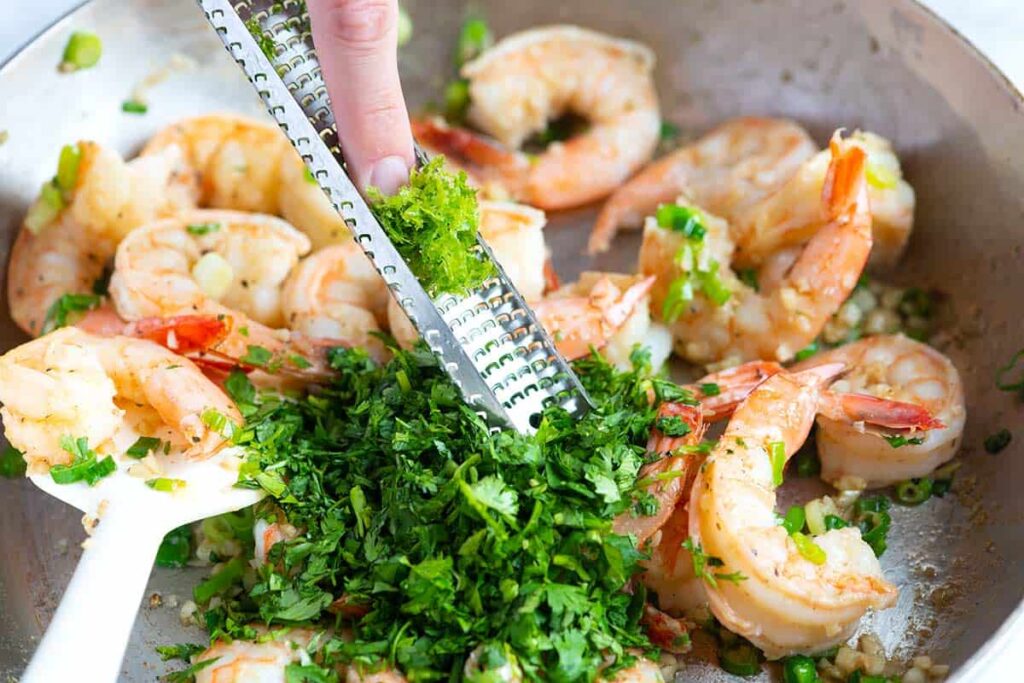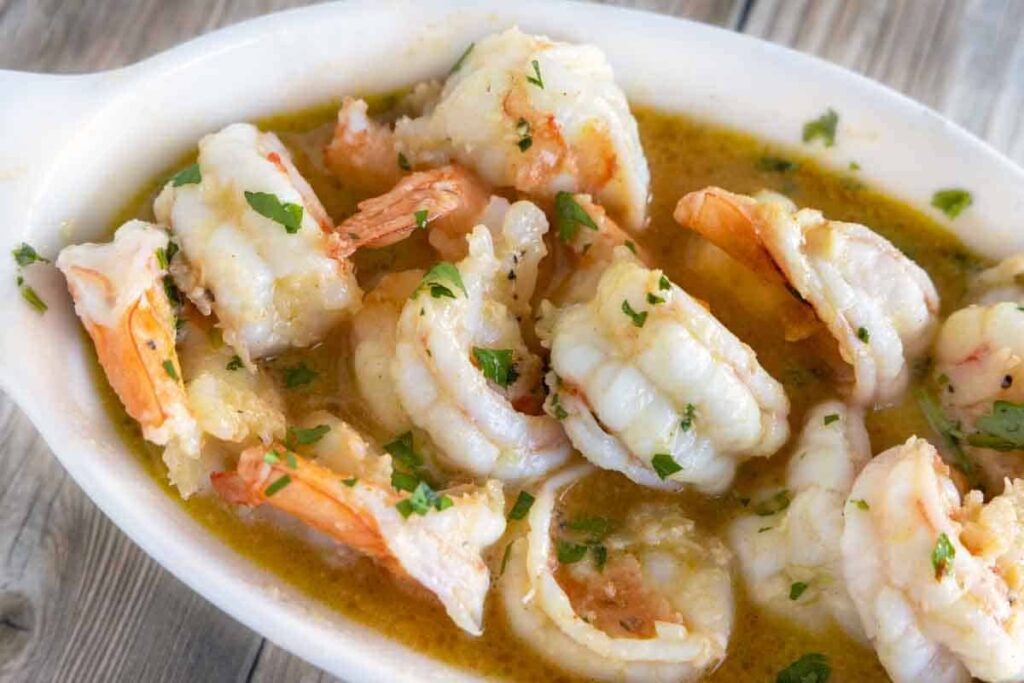How to Cook Buttered Shrimp: Buttered shrimp is a versatile and easy-to-make dish that’s perfect for any occasion. Whether you’re preparing a quick weeknight dinner or hosting a special gathering, this flavorful seafood dish can impress. In this article, we’ll guide you through the steps on how to cook buttered shrimp, discuss the essential ingredients, and highlight the health benefits of including shrimp in your diet.

Ingredients for Cooking Buttered Shrimp
To prepare delicious buttered shrimp, you’ll need the following ingredients:
- Shrimp: 1 pound of medium to large shrimp, peeled and deveined. Fresh or frozen shrimp can be used, but fresh shrimp provides the best flavor.
- Butter: 4 tablespoons of unsalted butter. Butter adds a rich, creamy taste to the dish.
- Garlic: 4 cloves of minced garlic. Garlic enhances the flavor profile of the shrimp and complements the buttery sauce.
- Lemon Juice: 2 tablespoons of fresh lemon juice. Lemon juice adds a zesty kick and balances the richness of the butter.
- Salt and Pepper: To taste. Season the shrimp to enhance their natural flavor.
- Parsley: 2 tablespoons of freshly chopped parsley. Parsley adds a fresh, herby finish to the dish.
- Red Pepper Flakes (optional): A pinch, for a touch of heat. This is optional but adds a nice spicy note to the dish.
- Olive Oil: 1 tablespoon of extra virgin olive oil. Olive oil is used for cooking the shrimp and adds a light, fruity flavor.
Learn More Recipe: How to Cook Aubergine
How to Cook Buttered Shrimp Step-by-Step Guide
Follow these simple steps to prepare a mouthwatering buttered shrimp dish:
Step 1: Prepare the Shrimp
Start by peeling and deveining the shrimp if they aren’t already prepared. Rinse them under cold water and pat them dry with paper towels. Ensuring the shrimp is dry will help them cook evenly and develop a nice sear.
Step 2: Heat the Pan
Place a large skillet over medium heat and add the olive oil. Let the oil heat up for a minute until it shimmers but doesn’t smoke. The hot pan is crucial for achieving a good sear on the shrimp.
Step 3: Cook the Shrimp
Add the shrimp to the hot skillet in a single layer. Cook them for about 2 minutes on each side or until they turn pink and opaque. Be careful not to overcrowd the pan, as this can cause the shrimp to steam instead of searing. Remove the shrimp from the pan and set them aside.
Step 4: Prepare the Butter Sauce
In the same skillet, reduce the heat to medium-low and add the butter. Allow the butter to melt, and then add the minced garlic. Sauté the garlic for about 1 minute until fragrant, stirring constantly to prevent burning.
Step 5: Combine Shrimp with Butter Sauce
Return the cooked shrimp to the skillet. Add the lemon juice, salt, pepper, and red pepper flakes (if using). Toss the shrimp in the butter sauce to coat them evenly. Cook for another 1-2 minutes to allow the flavors to meld together.
Step 6: Garnish and Serve
Remove the skillet from the heat and sprinkle the chopped parsley over the shrimp. Give it a final toss and serve immediately. Buttered shrimp can be enjoyed on its own or served over pasta, rice, or with a side of crusty bread to soak up the delicious sauce.
Learn More Recipe: How to Cook Chicken Schnitzel
Health Benefits of Shrimp
Shrimp is not only delicious but also offers several health benefits. Incorporating shrimp into your diet can contribute to a well-balanced and nutritious meal plan. Here are some of the key health benefits of shrimp:
High in Protein
Shrimp is an excellent source of lean protein, which is essential for building and repairing tissues, supporting muscle growth, and maintaining a healthy immune system.
A 3-ounce serving of shrimp provides about 20 grams of protein, making it an ideal option for those looking to increase their protein intake without consuming too many calories.
Low in Calories and Fat
Shrimp is naturally low in calories and fat, making it a great choice for those looking to maintain or lose weight. A 3-ounce serving of shrimp contains approximately 84 calories and less than 1 gram of fat, most of which is unsaturated. This makes shrimp a heart-healthy protein option that fits well into a variety of diets.
Rich in Essential Nutrients
Shrimp is packed with essential vitamins and minerals, including vitamin B12, selenium, iodine, and zinc. Vitamin B12 is crucial for maintaining healthy nerve cells and red blood cells, while selenium and iodine support thyroid function and boost the immune system. Zinc is important for wound healing and maintaining a healthy immune response.
Contains Omega-3 Fatty Acids
Shrimp contains omega-3 fatty acids, which are beneficial for heart health. Omega-3 fatty acids help reduce inflammation, lower the risk of heart disease, and support brain health. While shrimp doesn’t contain as much omega-3 as fatty fish like salmon, it is still a valuable source of these healthy fats.
Supports Bone Health
Shrimp is a good source of phosphorus, a mineral that plays a key role in maintaining strong bones and teeth. Adequate phosphorus intake, combined with calcium and vitamin D, can help prevent osteoporosis and maintain bone density as you age.

Promotes Healthy Skin and Hair
The astaxanthin in shrimp, a type of antioxidant, may help protect your skin from premature aging and damage caused by UV rays. Antioxidants combat free radicals in the body, reducing oxidative stress and promoting healthy skin and hair.
Tips for Cooking Perfect Buttered Shrimp
- Don’t Overcook: Overcooking shrimp can make them rubbery and tough. Cook shrimp just until they turn pink and opaque, usually about 2-3 minutes per side.
- Use Fresh Ingredients: Fresh garlic, lemon juice, and parsley make a significant difference in flavor. Fresh ingredients enhance the dish’s overall taste and provide additional health benefits.
- Experiment with Flavors: Feel free to customize the butter sauce with your favorite herbs and spices. Try adding fresh dill, basil, or a splash of white wine for extra flavor.
Conclusion
Cooking buttered shrimp is a quick and easy way to enjoy a delicious and nutritious seafood dish. With simple ingredients and minimal preparation, you can create a flavorful meal that is sure to please. Plus, with the numerous health benefits of shrimp, you can feel good about including this tasty dish in your diet. Whether served over pasta, rice, or enjoyed on its own, buttered shrimp is a versatile and satisfying option for any meal. So, gather your ingredients and get ready to cook a delightful dish of buttered shrimp that will impress your family and friends!
Learn More Recipe: How to Cook Pepper Soup
FAQ:
What kind of shrimp is best for buttered shrimp?
Fresh or frozen medium to large shrimp, peeled and deveined, are ideal for buttered shrimp. Fresh shrimp provide the best flavor, but frozen shrimp are a convenient option if properly thawed before cooking.
Can I use salted butter instead of unsalted butter?
Yes, you can use salted butter, but be mindful of additional salt when seasoning the dish. Using unsalted butter allows you to control the salt level more precisely.
How do I thaw frozen shrimp?
To thaw frozen shrimp, place them in a bowl of cold water for about 15-20 minutes. Once thawed, pat them dry with paper towels to remove excess moisture. Alternatively, you can thaw them overnight in the refrigerator.
Can I add other ingredients to the butter sauce?
Absolutely! You can customize the butter sauce with additional ingredients like white wine, chicken broth, or your favorite herbs and spices. Adding ingredients like paprika, cayenne pepper, or fresh herbs can enhance the flavor profile of the dish.
How do I prevent shrimp from becoming rubbery?
To prevent shrimp from becoming rubbery, avoid overcooking them. Shrimp cook quickly and should be removed from heat as soon as they turn pink and opaque, usually within 2-3 minutes per side.
Is buttered shrimp healthy?
Buttered shrimp can be part of a healthy diet when consumed in moderation. Shrimp is low in calories and high in protein, vitamins, and minerals. Opt for unsalted butter or use olive oil to reduce saturated fat content for a healthier version.
What can I serve with buttered shrimp?
Buttered shrimp pairs well with a variety of sides, including pasta, rice, quinoa, or crusty bread. It can also be served alongside a fresh salad or steamed vegetables for a well-balanced meal.
Can I use other types of seafood for this recipe?
Yes, the butter sauce used for this shrimp recipe can also be applied to other types of seafood, such as scallops, mussels, or lobster. Adjust the cooking times accordingly, as different seafood requires different cooking durations.
How do I store leftovers?
Store leftover buttered shrimp in an airtight container in the refrigerator for up to 2 days. To reheat, warm them gently in a skillet over low heat to avoid overcooking. Do not microwave, as this can make the shrimp rubbery.
Can I make buttered shrimp in advance?
While buttered shrimp is best served fresh, you can prepare the sauce ahead of time and store it in the refrigerator. When ready to serve, reheat the sauce and cook the shrimp just before serving for the best flavor and texture.
Learn More Recipe: How to Cook Chips in Air Fryer